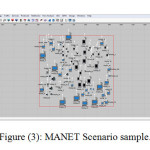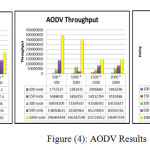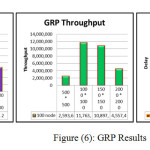Simulation Study to Observe the Effects of Increasing Each of The Network Size and the Network Area Size on MANET’s Routing Protocols
Saad Talib Hasson 1 And Sura Jasim
1Dean of Al-Musyab College for Engineering and Technology-University of Babylon, Iraq.
2MSc. Student, College of Sciences- University of Babylon, Iraq.
Article Publishing History
Article Received on :
Article Accepted on :
Article Published : 03 Jul 2014
Article Metrics
ABSTRACT:
Mobile Ad hoc Network (MANET) is one of the essential required wireless networks in this era. The routing process is one of the most important challenges that faces the designers and the managers of such networks. While, the performance evaluation is the main process that must be controlled in order to test, improve and develop any new or available MANET. This network’s performance can be measured using many metrics such as throughput, delay, overhead, etc. This paper represents a behavioral study for certain MANET Routing protocols using OPNET Modeler with respect to three performance metrics (Throughput, Routing Overhead and Delay). Different scenarios with different number of nodes (network size) and different network area size were applied and implemented. Three routing protocols namley (Adhoc On-Demand Distance (AODV), Optimized Link State Routing protocol (OLSR) and Geographic Routing Protocol (GRP)) were used and applied in this study.
KEYWORDS:
MANET, OPNET, AODV, OLSR, GRP, Throughput, Delay, Routing Overhead.
Copy the following to cite this article:
Hasson S. T, Jasim S. Simulation Study to Observe the Effects of Increasing Each of The Network Size and the Network Area Size on MANET’s Routing Protocols. Orient. J. Comp. Sci. and Technol;7(1)
|
Copy the following to cite this URL:
Hasson S. T, Jasim S. Simulation Study to Observe the Effects of Increasing Each of The Network Size and the Network Area Size on MANET’s Routing Protocols. Orient. J. Comp. Sci. and Technol;7(1). Available from: http://computerscijournal.org/?p=716
|
Introduction
MANET usually refers to the autonomous system without any centralized management. The expression ‘Ad Hoc’ means that this type of networks can take different forms. Because its quick and easiest deloyment, this type of network is feasible to be used in search, military, rescue operation, sensor networks and meeting rooms [Jogendra Kumar, 2012][Gurleen kaur wailed, 2013]. MANET can also be defined as an assortment of wirelesses mobile devices like (Laptops, Wireless phones, Personal Digital Assistants (PDAs) devices, printers, etc.) combined by wireless link with feature Bluetooth and/or IEEE 802.11 (Wi Fi) as shown in figure (1). All of them can move randomly in all the possible directions. MANETs suffer from the limitation of radio transmission scope, each one of this devices behaves as a host or router. These Nodes are communicate among them through intermediate nodes to transmit packets [Gurpinder Singh, 2012]. This paper contains a simulation study of the AODV, OLSR and GRP MANET’s routing protocols usingOPNET 14.5 Modeler. The study was exceeded with different network size and variable network area size. We felt that it is important to study the network ability of providing a proper level of service in spite of increasing the network size or the network area size.
Related work
Many authers applied their researches in the field of MANET’s Design and analysis. following are the most related work to this study.
Anjali and et al. at 2012 studied the performance of AODV, OLSR and GRP Routing protocols using OPNET. The simulation was done using one with IEEE-802.11a and other with IEEE-802.11g WLAN Standard. They used 80 and 100 nodes for each one of them. The data rate was 48 Mbps. They used: throughput, delay, the retransmission attempt and data dropped as a performance metrics. They took 1500×1500 M2 as an area. They concluded that the routing protocols performance was varying depending on the network [Anjali, et al. 2012].
Harmanpreet kaur and et al. at 2012 studied the performance of TORA, OLSR and GRP using OPNET Modeler. The data rate was 1Mbps, they used 1000×1000M2. They used 15, 50, 100 and 150 nodes to be the network size. They used the Load, Delay, Throughput and Routing Overhead as a performance metrics. They concluded that OLSR was the best in term of load and throughput, GRP was best in term of routing overhead and delay. TORA failed with all their performance metrics [Harmanpreet kaur et al., 2012].
Gagangeet1 Singh Aujla et al. at 2013 studied the performance of AODV, TORA, DSR, GRP and OLSR Routing protocols over 1000×1000M2 using OPNET Modeler. They studied the effect of increasing the network size in the network behavior using 30, 60 and 90 nodes. The e-mail and video conferencing were used as traffic. The performance metrics were delay, throughput, data dropped and load. Thy concluded that for e-mail and video conferencing traffics, AODV and GRP were good with small network size but OLSR was good with large network size. TORA and DSR were failed in both of these scenarios [Gagangeet1 Singh Aujla, et al. 2013].
Routing in MANET
The Routing process was defined as a process of choosing the path in a network in order to generate the traffic in this network. There are two activities must be performed in the routing concept: the first one is to determine the optimal routing path, while the other one is to transfer the packets through the network. This process is called the packet switching. The path determination means the routing algorithm that contains initialization and maintains the routing tables which include the route information for the packets. There are many strategies to discover the routes and maintaining it such as: Reactive, Proactive, Hybrid, Geographical, etc… . In the reactive type the source builds the route when it need, i.e. it doesn’t keep the routing table. In the Proactive type each node in the network has routing table that contain the information about the network topology. This table is updated periodically when the network changes its topology in order to save the new information about the new network topology. The geographic type uses Global Position System (GPS) in finding the information about the nodes location. These receivers built into the nodes to obtain their location info [Huda Al Amri, et al., 2010] [Atul Yadav, et al. 2013]. In this paper we took three routing protocols: Ad-hoc On-Demand Distance (AODV), Optimized Link State Routing protocol (OLSR) and Geographic Routing Protocol (GRP) as a reactive, proactive and geographic examples respectively.
3.1 AODV
It is a reactive routing protocol; it uses a control message in order to find the route between the source and destination nodes in the network when needs only. When the source node wants to send data to the destination node, it sends Route Request message (RREQ) to all its accessible neighbors, then all those nodes, if there is no one of them is a destination node, forward this message to their neighbors until the source node or the intermediate node that has a route to the destination node is located, the another message called Route Replay message (RREP) will be sent to the source node. Finally, the route between the source and the destination nodes will be created and they communicate with each other. This approach is useful in reducing the overhead [Ekta Nehra , et al., 2013].
3.2 OLSR
OLSR (Optimized Link State Routing) is a proactive routing protocol; it depends on the link state algorithm. As shown in figure 2, this protocol reduces the overhead by using Multipoint Relays (MPRs) nodes that used to retransmit the control message, which is the main feature of OLSR routing protocol. Using the pure link state protocol causes full flooding of control packets among the nodes. All the nodes receive the message and flood it to all its neighbors. This leads to increase the overhead in the network. The importance feature of OLSR routing protocol is to reduce this flooding of the control packets in the network by using MPRs technique. MPRs nodes are “a subset of all the one-hop neighbors of a node chosen in such a way that all two-hop neighbors are covered by this set. These nodes are the only nodes that forward broadcast messages during the flooding process” [Lady Noreen et al., 2009].
3.3 GRP
The GRP (Geometry-based Routing Protocol) is depending on its work on the node’s position using Global Position System (GPS) concept in order to trace the position of the nodes. Each node has its own local topology or local neighbors and stores the location of its neighbors (the location only) [W Ahmed et al., 2006].
4 Building the MANET’s Simulation
The following steps clarifies the logicl way to model the different MANET’s scenarios using OPNET Modeler:
- Select the area size.
- Select the number of nodes (network size).
- Select the node placement (ring, grid or random).
- Select the speed of the nodes.
- Determine the application (the traffic type).
- Determine the user profile.
- Setting the routing protocol type and its properties.
- Determine the mobility profile of all the mobile nodes.
- Select the required simulation statistics.
- Marking the animation viewer to observe the nodes movement during the simulation.
- Determine the simulation parameters (simulation time, type of simulation kernel, etc…).
- Run the simulation.
- Collect the result.
Generate the results web browser page
5 The Performance Metrics
In this paper, the throughput, End to end delay and the Routing overhead were taken to evaluate the suggested network performance :
- Throughput: – is a ratio between the total amounts of the received data to the time taken in order to receive the last packet by the receiver [Tahir Saleem, et al. 2010].
- End to End Delay: – the packet needs time to pass through the network; this time is called end to end delay. It is the time of transfering the packet from the source node to the destination node [Tahir Saleem, et al. 2010].
- Routing Overhead:- It was defined as” the total number of routing packets transmitted over the network, expressed in bits per second or packets per second” [P.Venkata Maheswara, et al. 2013].
6 Simulation Environment
In this paper, OPNET 14.5 (Optimized Network Engineering Tools) has been used as a network simulator in order to model and simulate many suggested scenarios. There are 60 scenarios were built ( 20 scenarios for each routing protocol). Table (1) shows the simulation environement used in building this study simulation senarios.
7 Results and Discussions
Many simulation runs were implemented and discussed. The final results and nindications were reviewed, collected and discussed for each protocol.
7.1 AODV
Figure (4) shows the network behaviour with the AODV routing Protocol. The used performance metrics were ; the overhead, throughput and delay. From the results we can indicate a certain increase in the routing overhead and throughput values with the increasing of the network size in each network area size. This is due to the increase of thenumber of the intermediate nodes between the source and the destination. When the network size remains constant and the network area size becomes large, the routing overhead was affected slightly, but the throughput decreasing. The delay has a different behavior over all the variable cases.
7.2 OLSR
Figure (5) shows the network behaviour with the OLSR routing Protocol. The used performance metrics were ; the overhead, throughput and delay. From the results we can found a slightly increasing in the routing overhead values with the increase of the network size in each of 100 and 150 nodes. And we notice decreasing in the throughput values with the increase of the network area size in each network size. But the throughput increases when the network size increases in the same network area size. Finally when the network size is 100 nodes, the delay was changed slightly and it has its minimum value over all the areas sizes. When the network size is 150 nodes, the delay increased and its value being the maximum with the area size of 2000m×2000m2. The delay was seemed to be the tangible with the 300 nodes in the area of 2000m×2000m2.
7.3 GRP
This protocol runs has a tangible limitation in its implementation with OPNET. It operates only with 100 nodes and less as a network size. Figure (6) shows the network behaviour with the GRP routing Protocol. The used performance metrics are ;the overhead, throughput and delay. From the results we can deduce that GRP can’t use properly with the large network size. All the performance metrics were found to be maximized when the network area size is 1000×1000 M2 and 1500×1500 M2.
Conclusion and the Future works
In this paper, we studied the performance of three routing protocols (AODV, OLSR and GRP). We concluded that with the OLSR, the increasing in the Routing Overhead is simultaneously with increasing the network area size and the network size. As well as, the increasing in the network size must be arranged with the increasing in the network area size; in order to perform a good behavior. With the AODV, it is possible to simulate 1000 nodes as a maximum network size, but the performance degrades when the network size becomes more than 300 nodes. This degradation related to the increasing in the routing overhead. The worst routing protocol was GRP. As a future work, one can use the area size to be greater than 4000000M2 in order to study the OLSR behavior with 500 and 1000 nodes. Also we can use another configuration for new suggested scenarios, i.e. ring or random configuration in addition to the random configuration to illustrate the difference among them in the performance metrics.
9 Refferences
- Anjali, Maninder Singh “Simulation and Performance Analysis of AODV,OLSR,GRP Routing Protocol by considering IEEE 802.11Standard” International Journal of Advanced Research in Computer Science and Software Engineering Volume 2, Issue 6, ISSN: 2277 128X, June 2012.
- Atul Yadav, Parag Joshi “Performance of Flat Routing Protocols in MANET” nternational Journal of Electronics and Computer Science Engineering 2035 Available Online at www.ijecse.org ISSN. 2277-1956, 2013.
- Ekta Nehra, Er. Jasvir Singh” Performance Comparison of AODV, TODV, OLSR and ABR using OPNET” International Journal of Advanced Research in Computer Science and Software Engineering, ISSN: 2277 128X, Volume 3, Issue 5, May 2013.
- Gagangeet singh aujla and Sandeep singh kang “Comparative analysis of AODV, DSR, GRP, OLSR and TORA by varying number of nodes with FTP and HTTP Applications over MANETs” in International Journal of Computer Applications Vol 65 No 2, March 2013.
- Gagangeet 1 Singh Aujla, Sandeep Singh Kang “Comprehensive Evaluation of AODV, DSR, GRP, OLSR and TORA Routing Protocols with varying number of nodes and traffic applications over MANETs ” IOSR-JCE Volume 9, Issue 3, Mar. – Apr.-2013.
- Gurleen Kaur Walia Article: “A Survey on Reactive Routing Protocols of the Mobile Ad hoc Networks”. International Journal of Computer Applications 64(22):45.51, Published by Foundation of Computer Science, New York, USA, February 2013.
- Gurpinder Singh “MANET: Issues and Behavior Analysis of Routing Protocols” International Journal of Advanced Research in Computer Science and Software Engineering Volume 2, Issue 4, ISSN: 2277 128X, April 2012.
- Huda AlAmri, Mehran Abolhasan, Tadeusz A. Wysocki:” Scalability of MANET routing protocols for heterogeneous and homogenous networks”. Computers & Electrical Engineering 36(4): 752.765, 2010.\
- Jogendra Kumar “Comparative Performance Analysis of AOD, DSR, DYMO, OLSR and ZRP Routing Protocols in MANET Using Varying Pause Time” International Journal of Computer Communications and Networks, Vol. 2, No. 4, Article 4, Publication date: December 2012.
- Kaur H., Singh J., “Performance comparison of OLSR, GRP and TORA using OPNET” , IJARCSSE Volume 2, Issue 10, Oct 2012.
- Lady Noreen P. Santos, BE “Voice Traffic over Mobile Ad Hoc Networks: A Performance Analysis of the Optimized Link State Routing Protocol”, M.Sc. Thesis, the Faculty Department of Electrical and Computer Engineering Graduate School of Engineering and Management Air Force Institute of Technology Air University, 2009.
- P.Venkata Maheswara, K. Bhaskar Naik “Routing Protocol Performance Issues and Evaluation Considerations in MANET” International Journal of Engineering Research and Applications (IJERA) ISSN: 2248.9622 www.ijera.com Vol. 3, Issue 4, pp-01-05, Jul-Aug 2013.
- Suchita Baxla, Rajesh Nema “A Review Paper on Performance Analysis of AODV, OLSR, DSR and GRP Routing Protocols of Ad hoc Networks” International Journal of Science and Research (IJSR), India Online ISSN: 2319-7064.
- Tahir Saleem, “Performance Issues of Routing Protocols in MANET”, MSc. Thesis, School of Engineering, Blekinge Institute of Technology, Sweden, 2010.
- W Ahmed, H Jiang, MS Kodialam, P Monogioudis “Location based routing for mobile ad-hoc networks” US Patent 7,006,453, Cited by 26, 2006.

This work is licensed under a Creative Commons Attribution 4.0 International License.







